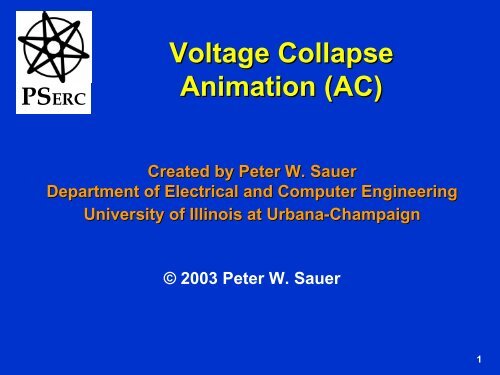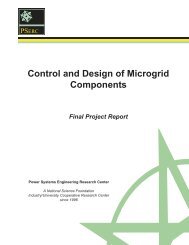AC Voltage Collapse - Power Systems Engineering Research Center
AC Voltage Collapse - Power Systems Engineering Research Center
AC Voltage Collapse - Power Systems Engineering Research Center
Create successful ePaper yourself
Turn your PDF publications into a flip-book with our unique Google optimized e-Paper software.
<strong>Voltage</strong> <strong>Collapse</strong><br />
PSERC<br />
Animation (<strong>AC</strong>)<br />
Created by Peter W. Sauer<br />
Department of Electrical and Computer <strong>Engineering</strong><br />
University of Illinois at Urbana-Champaign<br />
© 2003 Peter W. Sauer<br />
1
Introduction<br />
The following slides simulate a voltage collapse in a simple power system. The<br />
West generator has unlimited VAR (or reactive power) supply capability so it is<br />
able to keep the voltage at its bus constant at 1.0 per unit (or at the rated<br />
voltage). The East generator can only supply up to 1,200 MVARs (or 1,200<br />
million VARs). There are 6,000 MWs of real power load and 1,000 MVARs of<br />
reactive power load at each bus. The West generator is transferring 3,000 MW to<br />
the East to help serve the 6,000 MW load in the East. Therefore, the outputs of<br />
the West and East generators are 9,000 MW and 3,000 MW respectively.<br />
Six identical lines are initially in service and the 3,000 MWs of real power transfer<br />
are divided equally across the lines. The generators in the West and East are<br />
supplying reactive power (or VARs) to their local loads plus VARs to the<br />
transmission lines to support the transfer. The lines are assumed to be lossless<br />
(that is, they do not absorb real power). We have assumed that the individual line<br />
capacities (or thermal ratings) exceed 3,000 MW so the real power transfer could<br />
occur on one line if maintaining voltage (through sufficient VAR supply) is not a<br />
problem. Circuit breakers can open (or trip) the lines.<br />
2
Symbols in the Simulation Window<br />
• Buses: heavy dark lines (East and West) where the<br />
generators, loads and transmission lines interconnect<br />
• Transmission lines: lines connecting the two buses<br />
• Generators: circles with “dog bone rotors”<br />
• Loads: arrows connected to the buses<br />
• Circuit breakers: red boxes<br />
• Line flows: arrows on the transmission lines (more easily<br />
seen in the last three simulations that follow) indicate the<br />
direction and magnitude of power flow<br />
3
Simulating an <strong>AC</strong> System <strong>Voltage</strong> <strong>Collapse</strong><br />
Suppose the lines fail (that is, trip out) one at a time for any reason.<br />
Case 1: No Lines Out. Bus voltages at 1.0 per unit (or rated voltage). Both bus<br />
voltages are being controlled by their respective generator VAR supplies.<br />
Case 2: One Line Out. Bus voltages at 1.0 per unit (or rated voltage). Both bus<br />
voltages are being controlled by their respective generator VAR supplies.<br />
Case 3: Two Lines Out. Bus voltages at 1.0 per unit (or rated voltage). Both bus<br />
voltages are being controlled by their respective generator VAR supplies<br />
although the East generator has just hit its VAR limit.<br />
Case 4: Three Lines Out. East bus voltage at 0.99 per unit because East generation<br />
is at its reactive power supply limit. West generation still has unlimited<br />
reactive power supply capability.<br />
Case 5: Four Lines Out. East bus voltage drops to 0.97 per unit. East generation at<br />
its reactive power supply limit. West reactive power generation continuing to<br />
rise.<br />
Case 6: <strong>Voltage</strong> collapse! With five lines out, the simulation fails – which indicates<br />
that it is not possible to transfer 3,000 MW without additional reactive power<br />
support in the East even if West generation has excess reactive power<br />
supply capacity!<br />
4
Case 1: All Lines In-Service<br />
3,000 MW transfer – 500 MW per line<br />
West<br />
East<br />
6000 MW<br />
1000 MVR<br />
6000 MW<br />
1000 MVR<br />
9000 MW<br />
1150 MVR<br />
1.00 PU<br />
1.00 PU<br />
3000 MW<br />
1150 MVR<br />
<strong>Voltage</strong> is 100% of rated voltage.<br />
(300 MVARs required by lines).<br />
East generator is<br />
below 1,200 MVAR<br />
limit.<br />
5<br />
5
Case 2: One Line Out<br />
3,000 MW transfer – 600 MW per line<br />
West<br />
East<br />
6000 MW<br />
1000 MVR<br />
6000 MW<br />
1000 MVR<br />
9000 MW<br />
1176 MVR<br />
1.00 PU<br />
1.00 PU<br />
3000 MW<br />
1186 MVR<br />
<strong>Voltage</strong> is 100% of rated voltage<br />
(362 MVARs required by lines).<br />
East generator is<br />
below 1,200 MVAR<br />
limit.<br />
6<br />
6
Case 3: Two Lines Out<br />
3,000 MW transfer – 750 MW per line<br />
West<br />
East<br />
6000 MW<br />
1000 MVR<br />
6000 MW<br />
1000 MVR<br />
9000 MW<br />
1253 MVR<br />
1.00 PU<br />
1.00 PU<br />
3000 MW<br />
1200 MVR<br />
<strong>Voltage</strong> is 100% of rated<br />
(453 MVARs required by lines).<br />
East generator is at<br />
1,200 MVAR limit.<br />
7<br />
7
Case 4: Three Lines Out<br />
3,000 MW transfer – 1,000 MW per line<br />
West<br />
East<br />
6000 MW<br />
1000 MVR<br />
6000 MW<br />
1000 MVR<br />
9000 MW<br />
1411 MVR<br />
1.00 PU<br />
0.99 PU<br />
3000 MW<br />
1200 MVR<br />
<strong>Voltage</strong> is only 99% of rated<br />
(611 MVARs required by lines).<br />
East generator is at<br />
1,200 MVAR limit.<br />
8<br />
8
Case 5: Four Lines Out<br />
3,000 MW transfer – 1, 500 MW per line<br />
West<br />
East<br />
6000 MW<br />
1000 MVR<br />
6000 MW<br />
1000 MVR<br />
9000 MW<br />
1757 MVR<br />
1.00 PU<br />
0.97 PU<br />
3000 MW<br />
1200 MVR<br />
<strong>Voltage</strong> has dropped to 97% of rated voltage<br />
(957 MVARs required by lines).<br />
East generator is at<br />
1,200 MVAR limit.<br />
9<br />
9
Case 6: Five Lines Out<br />
<strong>Voltage</strong> <strong>Collapse</strong><br />
West<br />
East<br />
6000 MW<br />
1000 MVR<br />
6000 MW<br />
1000 MVR<br />
8926 MW<br />
3500 MVR<br />
1.00 PU<br />
0.77 PU<br />
3000 MW<br />
1200 MVR<br />
This simulation could not solve the case of 3,000 MW transfer with five<br />
lines out. Numbers shown are from the model’s last attempt to solve.<br />
The West generator’s unlimited supply of VARs is still not sufficient to<br />
maintain the voltage at the East bus.<br />
10<br />
10
















